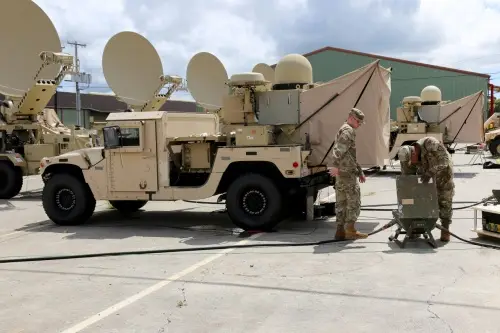SYNCHRONIZATION IS KEY
By MyBaseGuide Staff Member

Training and fielding network modernization requires a fully unified effort to ensure force readiness with the least possible disruption.
by Brent Smith, Lawrence Holgate and Amy Walker
To retain technological advantage over peer and near-peer adversaries, the Army must continually improve its ability to share data across the networkfrom the foxhole to the Pentagon. In support of that objective, the service conducted training and fielding of multiple new network transport capabilities across the 25th Infantry Division (ID), at Schofield Barracks, Hawaii, in three months.
Fielding numerous capabilities across a division in a short window of time provides distinct advantages: It saves resources, money and time for all stakeholders involved, and provides the unit ample time to train on the capabilities in operational exercises before they go on real-world missions. However, even more than other fielding efforts, it also requires a fully synchronized and unified approach to ensure force readiness with the least possible disruption to the units.
The Project Manager (PM) for Tactical Network, assigned to the Program Executive Office for Command, Control and Communications Tactical (PEO C3T), fielded the new network communications equipment to enhance the division's ability to exchange data and increase its operational flexibility, agility and the ability to "fight tonight."
Looking ahead, PM Tactical Network continues to plan, synchronize and execute unified fielding efforts across the force, including the 82nd Airborne Division, 3rd Infantry Division and 1st Armored Division. As technology advances, the organization will continue to conduct unified fielding efforts to efficiently and effectively modernize tactical network transport capability across the force.
EXPEDITIONARY, MOBILE, SIMPLIFIED, RESILIENT
U.S. Pacific Command (PACOM) "encompasses smaller, disparate land masses with great distances of water between them," said Maj. Grant Bramlett, communications officer for 3rd Infantry Brigade Combat Team (IBCT), 25th ID. "Due to the expanse and nature of the PACOM environment, it is imperative that the communications capabilities at every echelon be lightweight, simple to use and durable. The fielding of this new equipment allows us to retain that operationally ready state as it extends and strengthens our lines of communications and, in parallel, reduces the amount of equipment necessary to be immediately lethal upon arrival."
These new systems included the Modular Communications Node Advanced Enclave, a more expeditionary solution to exchange intelligence data; Coalition Network Extension Packages, which enable coalition network data exchange; and Secure Wi-Fi, which enables the network to come up in minutes versus hours of installing cables in a command post. Systems also included the Global Broadcast System, which provides one-way transmission of large data files like maps and video; and an improved battlefield video teleconferencing capability.
These systems were fielded to 25th ID units from January to March 2019 at Schofield Barracks, Hawaii. Additionally, as requested by the unit, PM Tactical Network fielded the inflatable Transportable Tactical Command Communications (T2C2) satellite terminals to the unit ahead of schedule, in November 2018, at the same location. T2C2 can be jumped on the backs of paratroopers or air-dropped to support initial entry missions, and it can be used in more mature operations to provide network connectivity at the tactical edge.
"Prior to this fielding, legacy network capability offered somewhat of a one size fits all' capability, not always conducive to the roughest of terrains," Bramlett said. "This tool suite allows us to plan and prepare for a wider variety of mission sets, as we are now able to tailor our communication capabilities to our actual needs."
Ahead of this fielding effort, the 25th ID's headquarters and two IBCTs exchanged their legacy at-the-halt tactical network equipment for enhanced on-the-move configurations. PM Tactical Network not only reduced system complexity and increased the reliability of these network vehicle integrations, but it also reduced the size, weight and power, making them more expeditionary. These enhancements include the modernized Tactical Communications Node Lite and Network Operations and Security Center Lite; and the Next Generation Point of Presence and Next Generation Soldier Network Extension.
"As America's Pacific division, the 25th Infantry Division continuously engages and trains with partners across the Pacific region," said Lt. Col. Malcom Bush, assistant chief of staff, G-6 for the 25th ID. "The division stands ready to deploy anywhere in the world to conduct operations ranging from humanitarian assistance and disaster relief to decisive action in support of unified land operations. We need reliable access to network services to enable the commander to make decisions based on information across every warfighting function. The [on-the-move tactical network equipment] allows for the dispersion of those warfighting functions, which increases our survivability."
UNIFIED AND SYNCHRONIZED
PM Tactical Network synchronizes network fielding efforts across the PM and PEO C3T to see where it can combine efforts and resources to increase efficiencies as much as possible. To begin the fielding process, the PM receives initial direction to field a unit from Department of the Army G-3/5/7 and PEO C3T. The Army facilitates the Mission Command Modernization Priority List, signed by its director of force modernization. Part of that document is the agreement with the Army service component commands, Army National Guard and Army Reserve that they can support fielding to the units on the list.
The priority list doesn't specify exactly when a unit will receive equipment, but it identifies which units should receive a new capability sooner based on operational need for that particular year. Commanders have short windows of time to be fielded with new technology and make it work seamlessly within their battle rhythm. It's up to the PEO and PM to work with the units to find enough time on the calendar that doesn't interfere with a unit's training exercises or mission support. Once the dates are lined up, the PM tries to maximize economies of scale by fielding as many systems as possible that are ready and can be configured in a unified manner, so units are disturbed only once, or as few times as possible.
PM Tactical Network not only looks at unit availability, but also works with the unit to define the availability of different military operational specialties. If it can get enough specialties to train in the same window, the PM can field and train multiple capabilities for that unit simultaneously.
Today, the Army builds systems-of-systems that are interlayered and interconnected. With this in mind, PM Tactical Network cross-trained engineer teams that can now support multiple capabilities and a more unified network, reducing the number of engineers and fielders that it needs to send to a fielding site. To further increase efficiencies and decrease the burden on units, the fielding site leads and field engineers supporting the program office are stationed at selected active Army posts across the country, enabling them to more easily engage units during fieldings and help synchronize modernization efforts, providing stability and continuity.
During integrated process team meetings, the PM Tactical Network fielding team, together with members of the PEO C3T Readiness Management Division, work together to overcome challenges and to synchronize current and future system and technical insertion fielding and training efforts, shipping, unit hand receipts, unit deployments and other efforts. Schedules change frequently, and one change can cascade into several more.
For this reason, the PM holds both monthly integrated process team meetings and biweekly scheduling meetings, and it partners with Department of the Army G-3/5/7 and PEO C3T for the weekly mission command synchronization meetings. These meetings ensure that staffs and teams are synchronized to meet priorities on the Mission Command Modernization Priority List or are adapting to approved changes based on PM Tactical Network's production allocations.
Fieldings are planned for and synchronized months, sometimes years, in advance, again to avoid disrupting the unit's competing operations or requirements. As such, a fielding will include multiple in-person meetings or teleconferences between units, their higher commands and the program managers, and that contact will increase in frequency as the established date draws near, Bramlett said.
"This allows all involved parties to repeatedly assess and respond accordingly to any issues or changes to the fielding timeline, be they unit-driven, a sourcing issue or a change in fielding priorities," Bramlett said.
As the fielding date or period gets closer, unit commanders and their staff members take part in meetings and briefings so that by the actual start, all are well-versed in what they are receiving, and how and why. For prolonged fieldings, progress meetings are conducted between the unit and program managers to ensure continuity of efforts. At the end of the fielding, the unit participates in an after-action review with the PM to go over any lingering questions, issues or challenges that may have surfaced from the fielding or were not previously addressed, Bramlett said.
IT'S ALL ABOUT READINESS
The Army works from the sustainment readiness model, which comprises three phases: prepare, ready and mission. Whenever possible, the Army prefers that new equipment be fielded and trained during the prepare phase, to allow plenty of time for units to become proficient. A large part of funded PM fielding efforts is comprehensive new equipment training, which ensures that units are ready to use the systems in an operational environment.
Following the PM-provided new equipment training, there must be enough time allocated for units to further train with systems during operational training exercises. It's important for combat commanders to rigorously and frequently repeat these training scenarios so that the units can be ready to support contingencies whenever called upon.
The 25th ID units will employ the new tactical network communications capabilities in multiple operational training exercises this year, including Lightning Forge at Schofield Barracks and its combat training center rotation at the Joint Readiness Training Center, Fort Polk, Louisiana. Units also will use the equipment during smaller exercises and events.
"We train as we fight, and we remain ready by practicing as often as possible, and this includes the employment of mission command as a system," Bramlett said. "One of the biggest challenges for units is how to meet all of their personnel, equipment and training requirements for a successful fielding, while remaining at an acceptable readiness state and [allowing] for the continued training in other pivotal areas."
CONCLUSION
Along with unification and synchronization, fielding efforts also require flexibility to veer away from set plans if necessary to support unexpected operations. Although most fieldings are planned well in advance, sometimes the PM must support immediate special requests based on operational need. For example, the 25th ID requested that one of its units be fielded with the T2C2 in November, versus later in the year, to support an unexpected mission, so PM Tactical Network quickly rearranged and customized plans to support this Army priority.
In the end, the equipment is meant to improve readiness and to help units connect and communicate as quickly as possible. As U.S. forces face increasingly capable enemies in multidomain battles, they need to be armed with a modernized network that is easy to use, resilient, expeditionary and mobile.
"The adversaries that we face in the near future are planning and preparing against the entirety of our force," Bramlett said. "A long, slow buildup of strength [on the battlefield] is not an option in this type of conflict. Our ability to conduct effective mission command will be determined by the equipment we can carry with us."
For more information, go to the PEO C3T website at http://peoc3t.army.mil/c3t/ or contact the PEO C3T Public Affairs Office at 443-395-6489 or usarmy.APG.peo-c3t.mbx.pao-peoc3t@mail.mil.
BRENT SMITH is the Readiness Management Division chief for PM Tactical Network. He has a B.S. in biology from St. Bonaventure University. He is Level III certified in logistics and Level II certified in program management, and is a member of the Army Acquisition Corps. He is also a DOD Acquisition, Technology and Logistics Key Leadership Position Board certified product support manager.
LAWRENCE HOLGATE is the fielding manager for PM Tactical Network. He has an M.S. in logistics management from the Florida Institute of Technology and a B.S. in geology from Penn State University. He is Level III certified in life cycle logistics and is a member of the Army Acquisition Corps.
AMY WALKER has been the public affairs lead at PM Tactical Network for the last 10 years and was the public affairs lead at PEO C3T for the previous two. She has covered a majority of the Army's major tactical network transport modernization efforts, including Army, joint and coalition fielding and training events worldwide. She holds a B.A. in psychology, with emphasis in marketing and English, from the College of New Jersey.
This article is published in the Summer issue of Army AL&T magazine.
SHARE:
TAGS:
JOIN OUR NEWSLETTER
Get the latest news and military discounts



